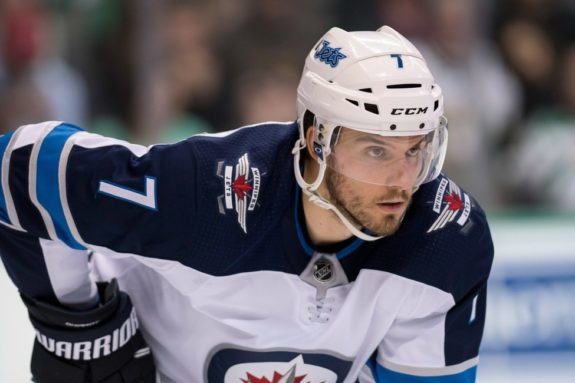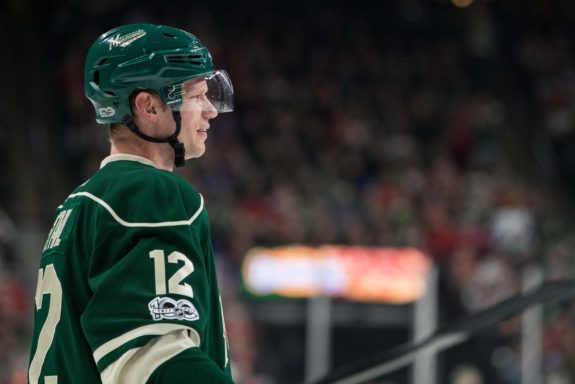The Winnipeg Jets came into Game 3 of their series against the Minnesota Wild flying high, no doubt feeling above the clouds thanks to two big-time wins and fervent fan support both in and outside Bell MTS Place.
Although their charter landed in the Twin Cities without incident — albeit a day late due to a historic blizzard that blasted Minnesota — the team itself had trouble landing on Sunday evening and skid right off the runway in a 6-2 loss.
I’ve found the black box: Here are three reasons the Jets crashed in Game 3.
Didn’t Adapt to Tighter Officiating
In the first two games of the series, officials were lax and content to let the players play. Game 3 was remarkably different. The refereeing duo of Tim Peel and Wes McCauley took a stricter approach. They showed they were determined to send a message that they wouldn’t tolerate the shenanigans of Game 2’s last-minute scraps and fisticuffs that spilled over into the first few minutes of Game 3.

The Jets did a poor job of adapting to Peel and McCauley’s no-nonsense approach. They took a few careless penalties on things they should have known wouldn’t fly with the new crew. Those penalties set them on a collision course from the get-go.
Ben Chiarot’s cross-check on Eric Staal and Adam Lowry’s liberties with Jason Zucker in a post-whistle brouhaha put the Jets down 5-on-3 and allowed the Wild to tie the game.
Another Chiarot cross-checking penalty quashed the chance the Jets had to head into the first intermission tied 1-1 even though they hadn’t played their best period — Zach Parise scored the go-ahead goal while the defenseman was stewing in the box.
#NHLJets D Ben Chiarot is called for cross-checking Charlie Coyle in the corner and #mnwild are back on the power play. Multiple stick fouls for both teams in this first period
— Ken Wiebe (@WiebesWorld) April 15, 2018
“There (weren’t) a whole lot of penalties the first two games,” Bryan Little said postgame. “They let a lot more go. It took us after that first period to kind of figure it out, what we could get away with. It was totally different.”
Jets Came Out Flat in Second Period
It was the second period where the trouble truly started for the Jets. The Winnipeg Sun’s Paul Friesen summed up their middle period performance well. They were “out of sync and out of sorts, fumbling with the puck, passing it to strange places and getting caught standing around in their own zone,” Friesen wrote in an article analyzing the game.
The Jets’ second period was by far their worst 20 minutes of playoff hockey thus far. They let up on their trademark forecheck, stopped using their speed, and lost their physical edge — three things they did so well in Games 1 and 2. As a result, Minnesota rattled off four goals in the period.

“We didn’t play anywhere near our level tonight,” Blake Wheeler said postgame. “It’s a fine line for us. We need to play with team speed like we were able to accomplish in the second half of both Games 1 and 2… we weren’t able to get to our speed that we needed to get to.
It was a huge departure from just two nights prior, when the Jets’ fourth line set the tone for the second period and the rest of the game by occupying the offensive zone for over 90 seconds and pursuing the puck like dogs after raw meat. They’re obviously capable of a lot better than they showed in Game 3.
Jets Couldn’t Contain Wild’s Top Players
In the first 2 games of the series, the Jets limited the offensive production of the Wild’s top guns. The five top point-getters in their lineup – Eric Staal, Mikael Granlund, Jason Zucker, Matthew Dumba, and Mikko Koivu — combined for only 3 points.
Game 3 was a different story. Similar to a bear waking up after a long winter slumber, Minnesota’s stars snapped out of their hibernation and ripped the Jets apart. The 5 aforementioned players tallied 8 points.
Wild coach Bruce Boudreau made some line adjustments prior to Game 3. He moved Mikael Granlund to a line with Eric Staal and Jason Zucker, and shifted Nino Niederreiter to a line with Mikko Koivu, hoping to light a fire under them.

It worked. The Jets seemed unprepared for the new combos, especially the new, deadly duo of Staal and Granlund. Staal, in particular, was a bee in their bonnet all night long. He assisted Granlund’s game-tying goal, then got the favour returned when he took a spin-o-rama pass and sniped a perfect shot top-shelf shot over Connor Hellebuyck’s blocker side shoulder.
What a pass. What a goal. #WPGvsMIN → https://t.co/62JQAt6zMy pic.twitter.com/Ur0rXnVQBq
— Minnesota Wild (@mnwild) April 16, 2018
Game 4 goes tomorrow at the Xcel Energy Center, and if the Jets want to get back off the ground and play to the level they did in Games 1 and 2, they’ll need to clean up these areas. If they don’t, they’ll be heading back to Winnipeg tied 2-2 instead of with a 3-1 series stranglehold.